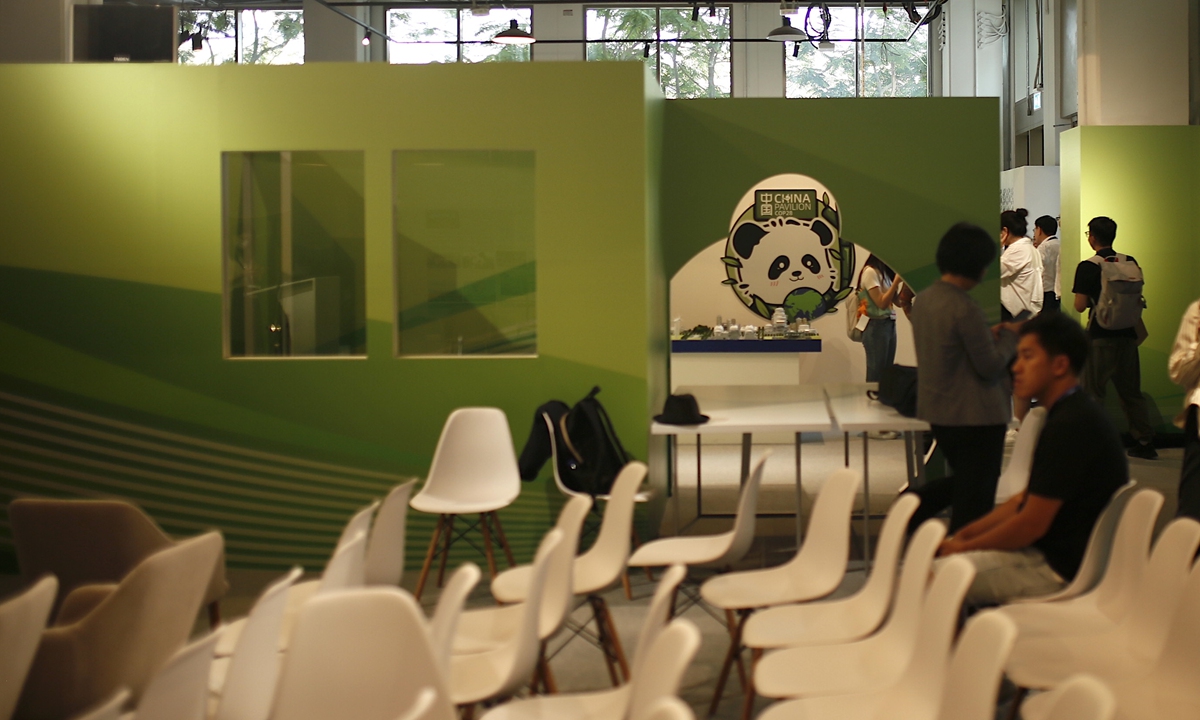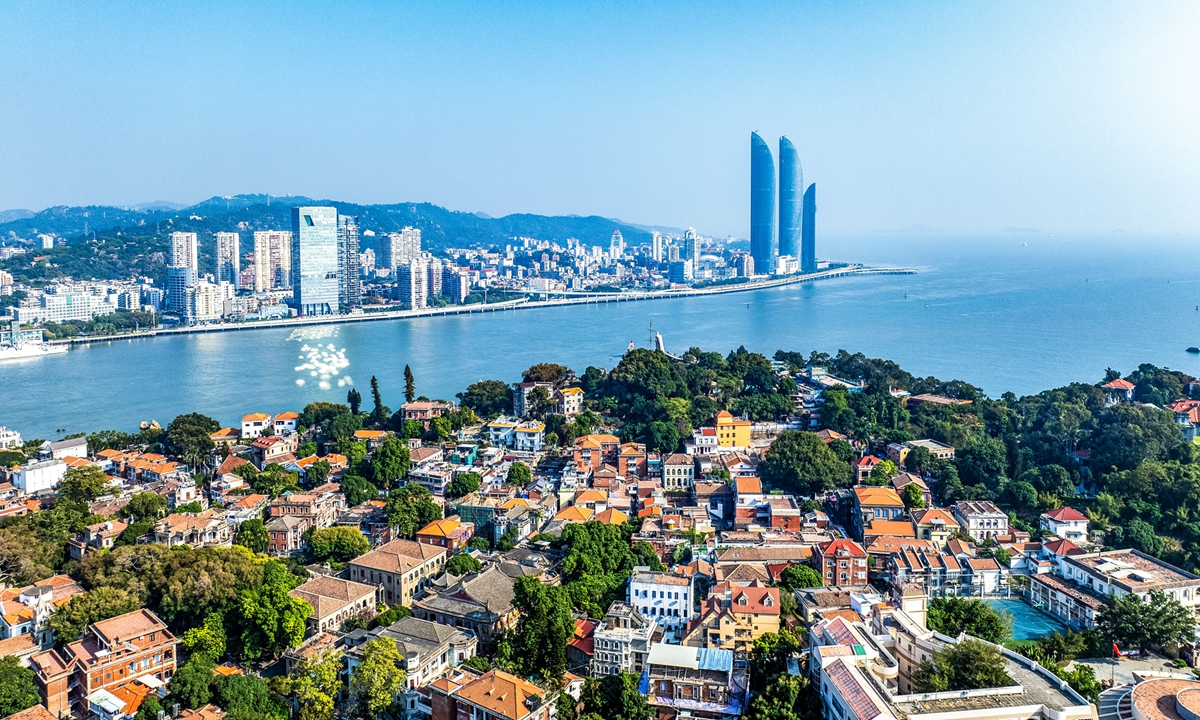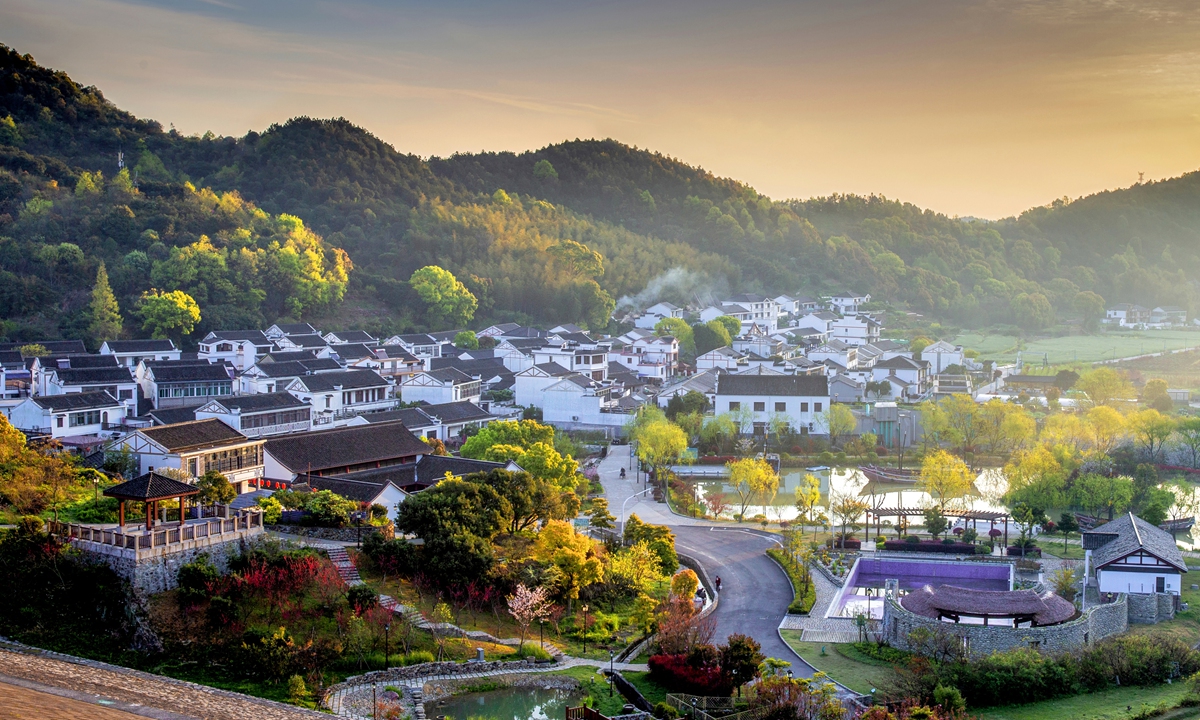IN-DEPTH / IN-DEPTH
lluminate roof of 'Beautiful China': Solar-powered rooftops transform countryside environments, boost rural revitalization efforts
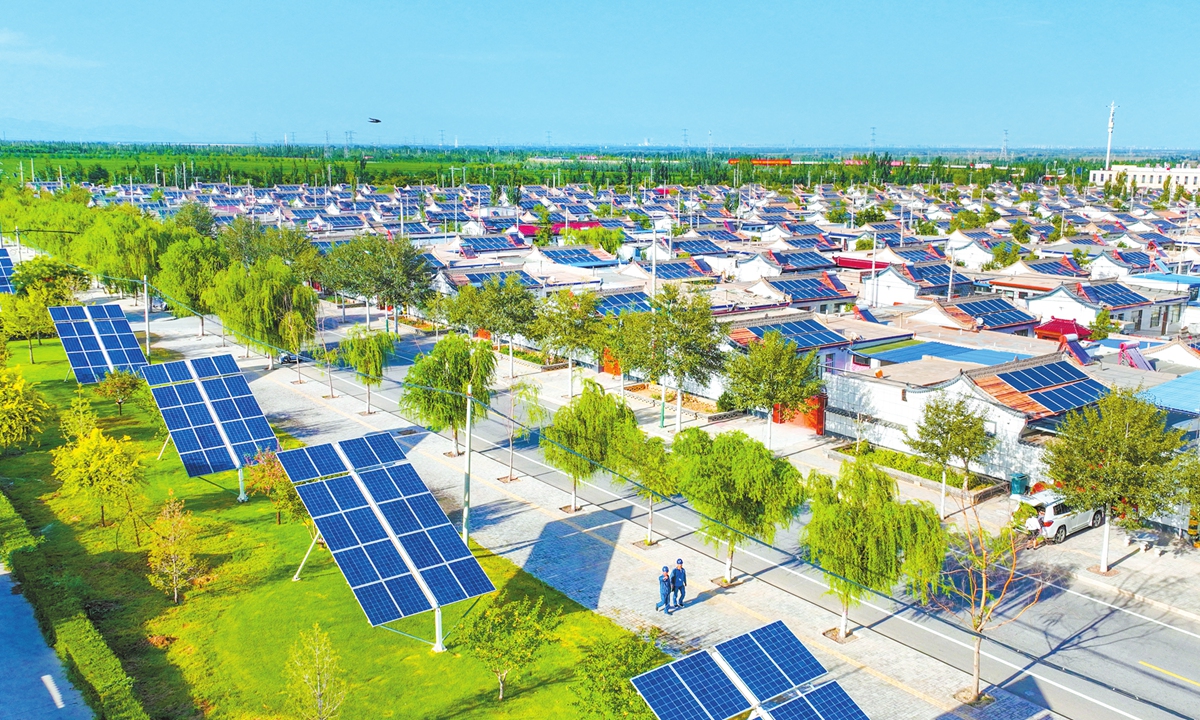
A view of Yuanlong village, where most residents have installed rooftop photovoltaic solar panels, in Northwest China's Ningxia Hui Autonomous Region. Photo: VCG
Editor's Note:As this year marks the 75th anniversary of the founding of the People's Republic of China, the Global Times has launched the second volume of its "Wish List" series, which documents ordinary Chinese people's wishes as a window into the changes in and achievements of the Chinese path to modernization.
In this volume, we present five representative stories that capture the aspirations and pursuits of individuals, which reflect the deep connection between national prosperity and people's destinies, illustrating how the Communist Party of China (CPC) and the country prioritize the well-being of the people in their quest for common prosperity, ecological civilization, and social harmony. They also bear witness to how Chinese people have marched forward toward Chinese modernization with high spirits.
This is the fifth and final installment in the series that tells the stories of a group of people living at the foot of China's Helan Mountains in Northwest China, who installed rooftop solar panels which can convert natural sunlight into electricity to eradicate poverty and contribute to the building of a "Beautiful China."
The upper part of the Chinese character "home" resembles a roof, symbolizing a home can only exist with a roof over it.
Today, an increasing number of Chinese people are creating environmentally friendly landscapes on the roofs they cherish most, showcasing a tangible "Beautiful China" through their homes.
In early winter, at the foot of the Helan Mountains, the sun still brightly shines over the vast Gobi Desert. When people enter Yuanlong village of Minning town, Northwest China's Ningxia Hui Autonomous Region, one can find rows of newly constructed agricultural residences with red tiles and white walls lining the road. From above, the blue photovoltaic panels glimmering on each red roof create a colorful mosaic under the sunlight.
Chinese people have aspired to convey their vision of harmony between heaven, earth, and humanity through architecture. Regarding the decision to install photovoltaic panels on the roof of her house, villager Zhang Hui told the Global Times that by installing photovoltaic panels on their roofs, they earn extra money, and the clean energy generated by the panels also gives them a channel to make their contribution to the country's emissions reduction and energy conservation efforts.
"We want to further emphasize the harmonious coexistence of humanity and nature, embodying a characteristic of Chinese modernization through our roofs," she said.
In recent years, China's solar photovoltaic technology is emerging as a key component of China's strategy to achieve its "dual carbon" goals, which aimed at achieving peak carbon emissions by 2030, and carbon neutrality by 2060.
The creation of this elevated landscape is a vivid representation of the Chinese people's efforts in building a "Beautiful China" in all respects. In this revolutionary transformation that involving production methods, lifestyles, and values, countless individuals have keenly perceived that China is keeping pace with the times, making a sound, inclusive ecological environment for the well-being of the people.
Cash in on the sun
For the residents of the village, installing rooftop solar systems and earning money from sunlight has now become a source of joy. "Because when you look up, you can see your own roof, and it reminds you of the abundant harvest you have," Zhang said.
Since 2016, Yuanlong village has successively built a 5-megawatt rooftop photovoltaic power station, supplied by photovoltaic panels on the roofs of over 1,635 immigrant households, accounting for nearly 96 of the village's total households. As of March 2024, this initiative had earned a total of 40.22 million yuan ($ 5.5 million) in photovoltaic revenue for the village.
Since 2018, Zhang's family has been renting the 54-square-meter rooftop to the power company, and the annual rental fee has increased from 300 yuan to 480 yuan as the power station has gradually entered a stable operating phase.
Beyond the tangible rental income, Zhang has also witnessed the thriving changes brought to her village by the rooftop photovoltaic power station program.
In 2020, the photovoltaic power station in Yuanlong village generated 850,000 yuan in revenue for the village collective. A portion of this revenue is distributed to villagers as rental fees, while another part is used as dividends for the village collective's shares, funding various public welfare expenditures such as environmental sanitation improvements, major illness assistance for villagers, and education support.
The Global Times has learned how the rooftop solar systems program in Yuanlong village was operated: the local government attracts external investment to bid for the construction of a photovoltaic power station, guarantees a 100 percent buyback of the project's output, ensuring that the village and its residents will receive 100 percent of profits during the 20-year operational period of the power station.
"Turning green, clean energy advantages into economic development advantages is a new concept for us," said Ha Manpeng, 44, a villager from Yuanlong
Ha and many other villagers learned that the area they live has a high altitude, flat terrain and long sunlight hours, making it suitable for the installing of clean and efficient solar photovoltaic systems
"Simply retrofit the vacant roof, there will be a stable and long-term additional benefit. The manufacturers cooperating with the government will regularly send personnel to maintain, and regularly update the equipment, thus we have nothing to worry about," Ha said.
Comfort life out of mountains
Zhang jokingly remarked that rooftop solar power generation has allowed the Yuanlong's villagers to truly transition from a weather-dependent life to "making money from the weather."
The over 10,000 villagers in Yuanlong were moved from another village - Xihaigu in 2012, which is a largely mountainous region that was labeled the "most unfit place for human settlement" by the United Nations in the 1970s due to land reclamation, drought, and a fragile ecological environment.
Ha recalled his childhood living in the village hidden in the folds of the mountains, where every household was plunged into darkness at night.
Over the past 40 years, Ningxia launched six large-scale resettlement schemes, moving some 1.23 million people from Xihaigu to more habitable areas. The relocation was part of the poverty alleviation drive, fulfilling many villagers' desire for a comfortable life out of the mountains.
Having escaped the vicious cycle of ecological and survival crises, what kind of life and development path did the villagers of Xihaigu choose in their new homes?
Yuanlong village is one of the villages that has benefited early from the income generated by photovoltaic power stations. Ha was among the first residents to install solar panels on roof.
Initially, Ha's personal experience with the five photovoltaic panels installed on his roof was simply that they provided shade on sunny days, and made the roof less prone to leaks on rainy days. As more households in the village adopted the solar rooftops, Ha witnessed a profound improvement in the living conditions of the villagers, along with an increase in their income.
As of November 2020, China had achieved the feat of delisting all 832 poverty-stricken counties. The development of photovoltaic power stations, as a typical model of industrial poverty alleviation, has contributed to this historic achievement.
According to China's National Energy Administration, by the end of 2020, China had built photovoltaic power stations with a combined capacity of 26.36 million kilowatts, generating approximately 18 billion yuan in annual electricity revenue, and creating 1.25 million public welfare jobs.
When this clean, low-carbon, safe, and efficient energy enters the homes of ordinary people, it not only provides shelter through new types of rooftops for families, but also supports more Chinese people in achieving a moderately prosperous life. Many residents have come to realize that their choices contribute to the country's energy conservation and emission reduction efforts.
They want to do even more.
"When I was a child, there was no electricity in my home, but now we can even produce electricity at home. In our village, people prefers to buy new energy vehicles. Waste sorting has become a habit for the villagers," Ha said.
"When we go out traveling, the children can immediately 'capture' solar panels everywhere. They are also very happy to see that more and more villages began to install solar rooftops just like us," Zhang added.
Green electricity town
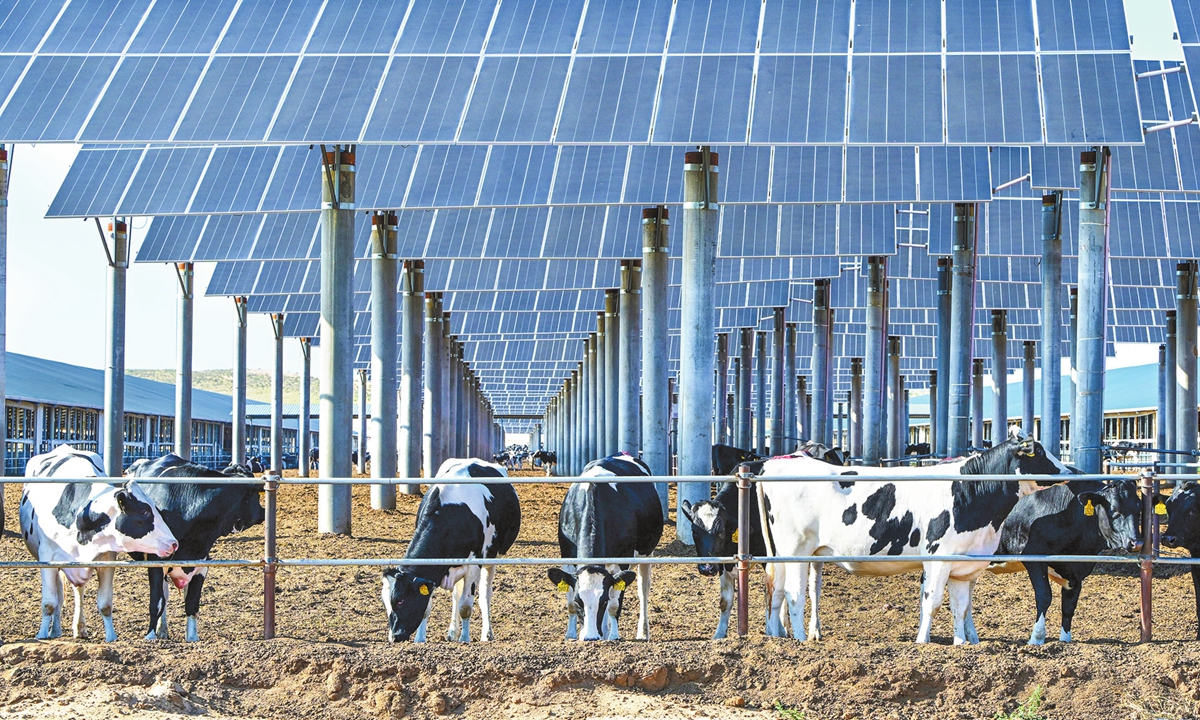
A herd of cows graze peacefully beneath neatly arranged solar panels at an eco-friendly livestock farm in Yinchuan, Ningxia Hui Autonomous Region, on August 12, 2024. Photo: VCG
Facing the changes in life, as an official of the Yuanlong village, Zhang's focus has gradually shifted from the land owned by villagers to the cattle and sheep they raise, and the job opportunities available to them. Now, she is also gradually learning to consider all these key aspects within the context of the new era of development she is in.Whenever representatives from enterprises and communities visit Yuanlong village, Zhang highlights the embroidery skills of the local women and the solar roofs they have.
One of Zhang's proudest achievements this year has been helping to showcase and sell the village women's embroidered crafts to a power supply company in Fuzhou, East China's Fujian Province. She is very proud that this "green collaboration" has broken through regional limitations, built more bridges for communication between her village and the outside world, and empowered the development of local women.
With the official launch of the "green electricity town" project in Minning town in August 2023, which aims to create a new type of system demonstration area powered entirely by clean energy 24 hours a day, the project is expected to reduce carbon emissions by 48,000 tons annually once completed.
Zhang believes that the villagers in Yuanlong will have more opportunities to showcase their talents and felt gratified that she is living in a country that pays more attention to protecting the ecological environment.
At a national conference on ecological and environmental protection held in July 2023, Chinese President Xi Jinping has stressed efforts to promote the building of a Beautiful China in all respects and accelerate the advancement of modernization featuring harmony between human and nature.
The next five years is a crucial period for building a Beautiful China, which should be placed in a prominent position in building a great modern socialist country in all respects and advancing national rejuvenation, Xi said.
The country should support high-quality development with a high-quality ecological environment and promote the modernization featuring the harmonious co-existence between human and nature, he noted.
Looking up at her rooftop, Zhang eagerly awaits the completion of the "green electricity town." She hopes it will build a stronger bridge connecting the common people's dream of a better life with the country's plans for emission reduction and energy conservation, leading to a more "Beautiful China."
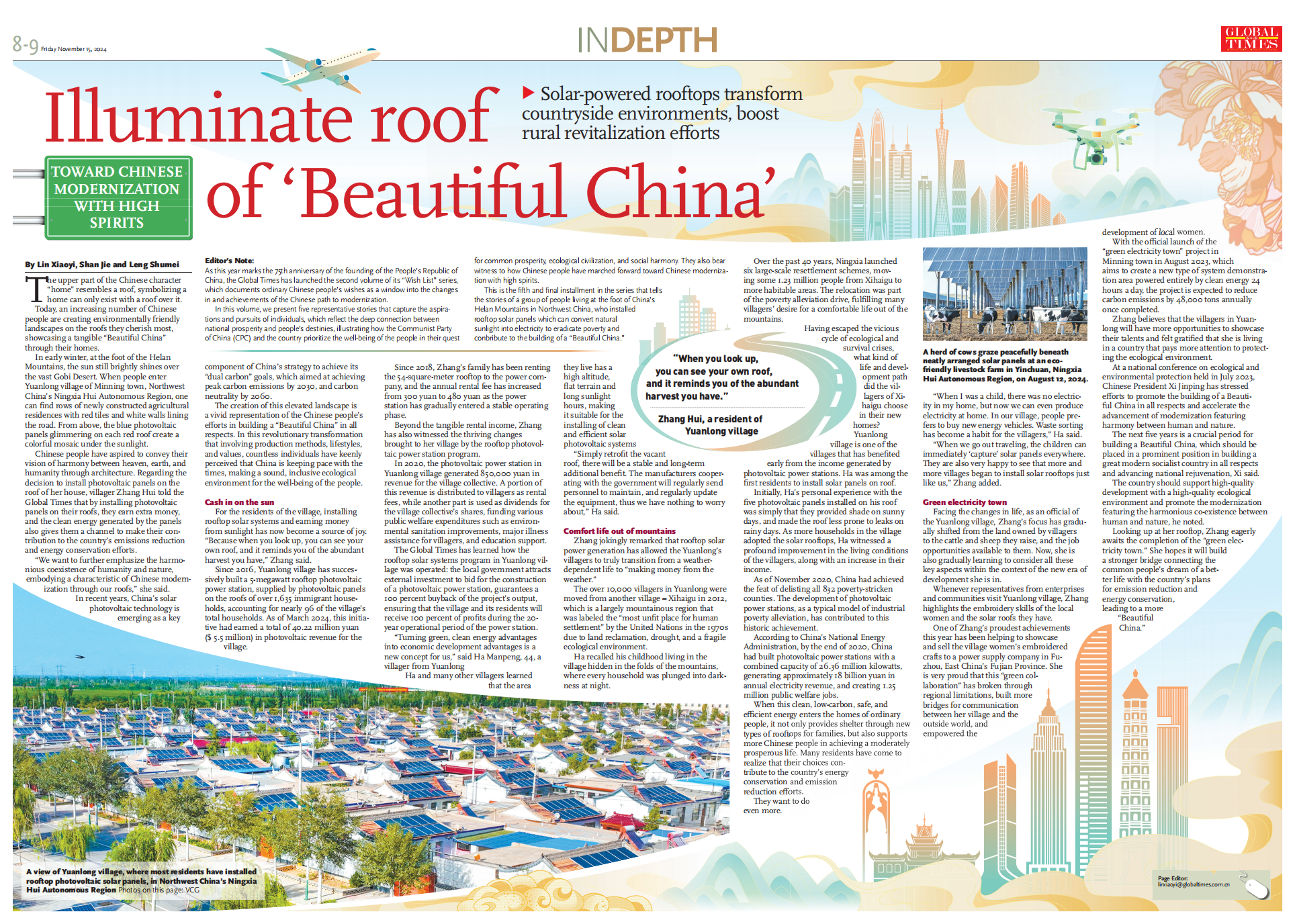
Illuminate roof of 'Beautiful China'

